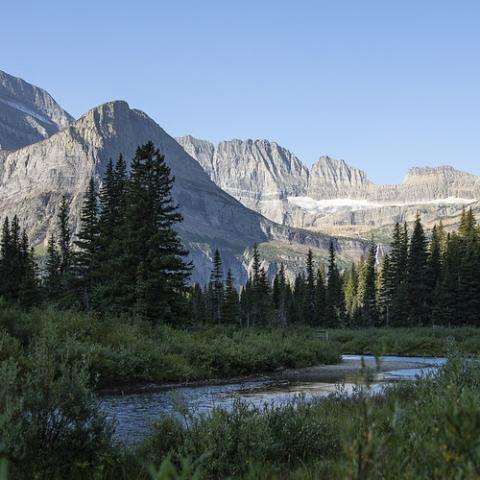
A native westslope cutthroat trout, Glacier National Park / NPS
At least two conservation organizations are filing a federal lawsuit alleging the National Park Service and the U.S. Fish and Wildlife Service have illegally approved a trout introduction plan for Glacier National Park’s Gunsight Lake in Montana.
The park’s plan is to plant bull trout and west slope cutthroat trout in the lake. Those fish species are native in the area, but those fish never historically inhabited Gunsight Lake—a large waterfall blocks entrance to the lake for fish downstream—and they aren’t present in the lake today.
Resident, non-native rainbow trout are, however, present at Gunsight Lake, and the project will begin by eradicating those first. Gunsight Lake was historically fishless until the introduction of non-native cutthroat trout and rainbow trout in the first half of the twentieth century. Those non-native trout have established a self-sustaining population in the lake, and have migrated downstream since their introduction. They've since bred with the native westslope cutthroat trout, hybridizing that population and putting them under risk.
The park service and the USFWS are hoping that by removing the non-native trout, they’ll end the hybridization threat. Further, planting the bull and cutthroat trout species in the lake gives those native species a safe place to breed, establish a population, then potentially develop a breeding population downstream throughout the St. Mary river drainage.
Native trout young will be collected from populations in nearby streams, and raised in a hatchery where they’ll be bred, then introduced into Gunsight Lake.
On September 16, the conservation groups Friends of the Wild Swan and the Council on Wildlife and Fish brought filed a lawsuit in opposition to the federal agencies. They argue the agencies’ plan violates the Endangered Species Act by essentially experimenting on bull trout, which are listed as a threatened species. They further allege the proposal violates the National Environmental Policy Act and the Administrative Procedures Act.

Gunsight Lake / NPS
“[The plan] never analyzes or discloses key questions on how many bull trout it will take from streams, from what particular streams it will take them, at what hatchery it will propagate them, or how many it will introduce into Gunsight Lake to establish a genetically viable population,” the groups said in a release.
“The vague plan lacks essential, foreseeable details because the agency wanted to finish the plan later with the U.S. Fish and Wildlife Service — outside the light of public notice and comment,” the groups said. “This failure to explain the reasonably foreseeable details of the plan and failure to allow public comment violates the National Environmental Policy Act (NEPA).”
The park has previously, however, conducted similar efforts to extirpate non-native trout and replace them with native fish in other water bodies. Native trout have seen dramatic declines in their historical range, and the fish that are left are increasingly competing with non-native and hybridized trout species, leaving the pure genetic strains, that have lived in the region for thousands of years, at risk.
“Unless proactive conservation and recovery programs are implemented immediately, Glacier National Park’s westslope cutthroat and bull trout will continue to become hybridized and will become extirpated east of the Divide,” said Clint Muhlfeld, a biologist with the U.S. Geological Survey. “This is all we have left to protect, preserve and restore. And without management intervention, we’re going to lose it.”
Glacier National Park declined to comment for this article, citing an unwillingness to speak on the record about ongoing litigation.




 Support Essential Coverage of Essential Places
Support Essential Coverage of Essential Places







Add comment